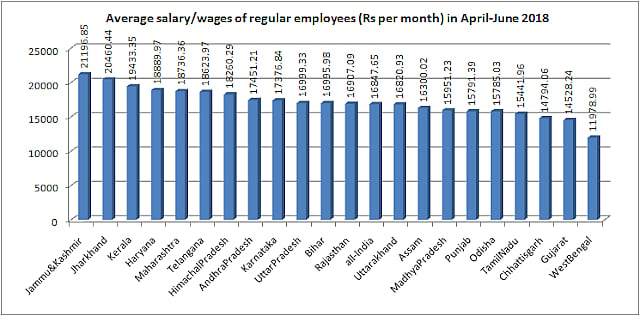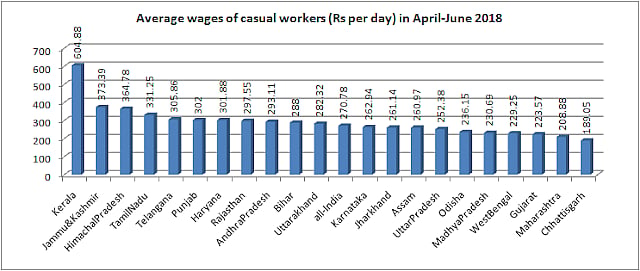Gujarat’s regular, casual workers earn less than 19 top states
Gujarat’s unemployment rate, reflected in a recent report released by the Government of India, is 4.8%, lower than the national average, 6%.

Though not as low as state chief minister Vijay Rupani claims it to be (0.9%), Gujarat’s unemployment rate, at least as reflected in a recent report released by the Government of India, is 4.8%, lower than the national average, 6%. Yet, ironically, the same report, released soon after the Lok Sabha polls came to an end in May 2019, brings to light an even grimmer reality: Lower wages in "model" and "developed" Gujarat compared to virtually the whole of India, including the so-called Bimaru states.
Published by the Ministry of Statistics and Programme Implementation, and based on a survey carried out across India between July 2017and June 2018, the report, “Annual Report: Periodic Labour Force Survey (PLFS)”, suggests that per month average wages or salary earnings for regular employees in Gujarat during April-June 2018 was Rs 14,528.24, which is lower than all major 21 states with the exception of West Bengal (Rs 11,978.99).
Low wages do not bog what are called “regular employees”; things are no different with regard to casual labour. Thus, according to the PLFS report, average earnings of a casual worker in Gujarat during April-June 2018 was found to be just Rs 223.57 per day, lower than all major 21 states with the two states -- exception of Chhattisgarh (Rs 189.05) and Maharashtra (Rs 208.88).
The PLFS report finds that, among 21 major states, regular workers’ average wages/salaries per month during April-June 2018 were the highest in Jammu & Kashmir (Rs 21,197), followed by Jharkhand (Rs 20,460), Kerala (Rs 19,433), Haryana (Rs 18,890), Maharashtra (Rs 18,736), and Telangana (Rs 18624). On the other hand, Kerala’s average casual wages per day were found to be the highest in India (Rs 605), followed by J&K (Rs 374), Himachal Pradesh (Rs 365), Telangana (Rs 306), and Tamil Nadu (Rs 331).

The all-India average for the wages/salary earnings of regular earnings is Rs 16,847.65, and for casual workers Rs 270.78, much higher than Gujarat. Interestingly, while the PLFS report refuses to give any explanation for the reason behind such low wages for both regular and casual workers, the Modi government’s thinktank Niti Aayog asserted in 2017 that while there have been “low and stable rates of unemployment over more than three decades”, the more serious problem, instead, is “severe underemployment.”
Citing acceptance of jobs with poor wages, a report gave anecdotal evidence to prove this. It said. “A recent advertisement for the post of 14 sanitary workers in Tamil Nadu secretariat attracted 4,000 applications, and these included a large number of engineers and MBA graduates. Goutam Das, in his book ‘Jobonomics’, estimates that India would have as many as 20 crore underemployed people with ‘bad jobs’ or no jobs by 2025.”
Taking a more focused view, the world’s top consultants, McKinsey, has suggested that low official unemployment rate “hides the fact that India has a huge army of underemployment”, pointing out, in India’s context “unemployment is not really an option”, and here “entering the informal sector as a worker is the norm.”
“Some 86% of India’s workforce is employed in the informal sector, and more than 90% is in informal employment”, the McKinsey Global Institute report says, underlining, “Rarely would a poor rural boy who had dropped out of school remain ‘unemployed’ – he would typically be put to ‘work’ on his family’s small piece of land or would lend a hand at the local kirana shop owned by his uncle.”
Not without reason, the data provided by the PLFS report, too, suggest that among the poorer sections very few poorer were “unemployed” compared to those who were educated, whether in Gujarat or in India. Thus, among those identified as “not literate” in the survey, just 1% reported as having been unemployed in Gujarat and 1.2% all-India. As for those educated up to primary level, the survey found 1.7% unemployment rate in Gujarat and 2.7% all-India.

On the other hand, in Gujarat, the unemployment rate among those who are finished higher secondary is 6.3%, those with diploma or certificate course a whopping 22.6%, among graduates 8.7%, and among post-graduates and above 10.8%. One witnesses a similar trend all-India: 10.3 among those who have finished higher secondary, it is 19.8% among those who have diploma or certificate courses, 17.2% among graduates, and 14.6% among post-graduates and above.
While it is a mystery what percentage of people in Gujarat, or for that matter in India, are underemployment, according an expert definition, “Underemployment refers to people who are working in a lower capacity than they are qualified for, including in a lower-paid job or for fewer hours than they would like to work. It’s different from unemployment in that the person is in fact, working, just not as much as they’d like or to the full extent of their abilities, skills, or education.”
Follow us on: Facebook, Twitter, Google News, Instagram
Join our official telegram channel (@nationalherald) and stay updated with the latest headlines
Published: 20 Jul 2019, 8:29 AM
